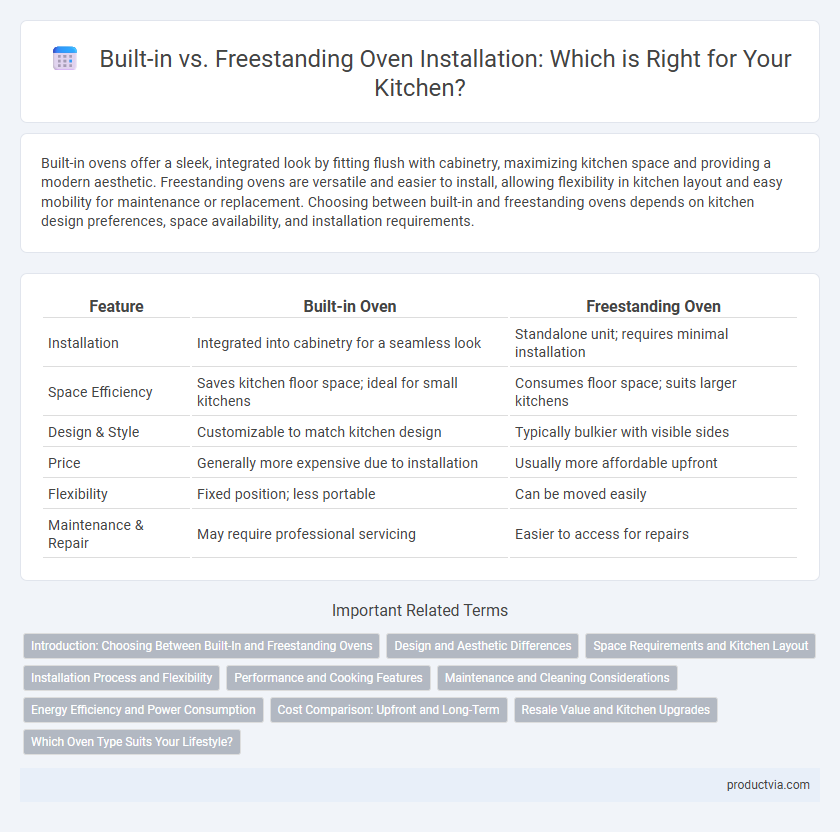Built-in ovens offer a sleek, integrated look by fitting flush with cabinetry, maximizing kitchen space and providing a modern aesthetic. Freestanding ovens are versatile and easier to install, allowing flexibility in kitchen layout and easy mobility for maintenance or replacement. Choosing between built-in and freestanding ovens depends on kitchen design preferences, space availability, and installation requirements.
Table of Comparison
| Feature | Built-in Oven | Freestanding Oven |
|---|---|---|
| Installation | Integrated into cabinetry for a seamless look | Standalone unit; requires minimal installation |
| Space Efficiency | Saves kitchen floor space; ideal for small kitchens | Consumes floor space; suits larger kitchens |
| Design & Style | Customizable to match kitchen design | Typically bulkier with visible sides |
| Price | Generally more expensive due to installation | Usually more affordable upfront |
| Flexibility | Fixed position; less portable | Can be moved easily |
| Maintenance & Repair | May require professional servicing | Easier to access for repairs |
Introduction: Choosing Between Built-In and Freestanding Ovens
Built-in ovens provide a seamless, integrated look by fitting flush with cabinetry, ideal for customizing kitchen layouts and saving counter space. Freestanding ovens offer flexibility in placement and typically include both the oven and stovetop, making them easier to install and replace. Selecting between built-in and freestanding depends on kitchen design preferences, space availability, and desired appliance functionality.
Design and Aesthetic Differences
Built-in ovens offer a sleek, integrated look that blends seamlessly with cabinetry, enhancing modern kitchen designs with minimalist appeal and customized height options. Freestanding ovens provide a versatile and traditional aesthetic, easily placed anywhere in the kitchen with visible sides and backs, often featuring decorative finishes and controls on the front panel. The choice between built-in and freestanding ovens significantly impacts the kitchen's visual flow and space utilization, influencing overall design harmony and functionality.
Space Requirements and Kitchen Layout
Built-in ovens save countertop space by integrating seamlessly into cabinetry, ideal for compact kitchens or custom layouts that prioritize a streamlined appearance. Freestanding ovens require a dedicated space with clearances on all sides, offering flexibility in kitchen placement but demanding more floor area. Choosing between built-in and freestanding ovens depends on available kitchen space, desired aesthetics, and overall layout functionality.
Installation Process and Flexibility
Built-in ovens require precise cabinet measurements and professional installation, offering a streamlined, integrated look tailored to kitchen design. Freestanding ovens provide greater flexibility, allowing easy relocation and simpler setup without permanent fixtures. Choosing between the two depends on kitchen layout preferences and whether a seamless aesthetic or versatile placement is prioritized.
Performance and Cooking Features
Built-in ovens offer superior integration with kitchen cabinetry, providing consistent heat distribution and advanced cooking features like convection and steam options for precise temperature control. Freestanding ovens tend to be more versatile in placement, often featuring larger capacities and multiple broiler settings, but may lack the seamless temperature stability found in built-in models. Choosing between built-in and freestanding ovens depends on the desired balance of performance, cooking technology, and kitchen layout flexibility.
Maintenance and Cleaning Considerations
Built-in ovens often feature smooth surfaces and integrated designs that simplify cleaning by minimizing gaps where dirt and grease can accumulate. Freestanding ovens may require more frequent maintenance as their exposed sides and backs are prone to dust buildup and harder-to-reach areas, demanding thorough cleaning. Choosing a built-in oven can reduce long-term maintenance efforts due to streamlined cavity designs that facilitate easier access for wiping and upkeep.
Energy Efficiency and Power Consumption
Built-in ovens typically offer better energy efficiency than freestanding models due to their integration within cabinetry, which provides improved insulation and reduces heat loss during cooking. Freestanding ovens may consume more power as they rely on external ventilation and are less insulated, leading to potential heat escape and longer cooking times. Choosing a built-in oven can lead to lower electricity bills and enhanced thermal performance through optimized heat retention.
Cost Comparison: Upfront and Long-Term
Built-in ovens often require higher upfront costs due to customized cabinetry and professional installation, while freestanding ovens generally offer lower initial purchase and setup expenses. Over the long term, built-in ovens may provide better energy efficiency and space optimization, potentially reducing utility bills and enhancing kitchen resale value. Freestanding ovens can incur additional costs related to fitting and less efficient use of kitchen space, impacting overall value and maintenance expenses.
Resale Value and Kitchen Upgrades
Built-in ovens enhance kitchen aesthetics and often boost resale value by creating a streamlined, modern look favored by buyers, while freestanding ovens offer flexibility and easier installation. Homeowners seeking long-term investment typically prefer built-in models as they integrate seamlessly with cabinetry, increasing appeal during home sales. Freestanding ovens may limit kitchen upgrades due to their bulkier design, whereas built-in units support customization and efficient use of space.
Which Oven Type Suits Your Lifestyle?
Built-in ovens offer a sleek, integrated look ideal for modern kitchens and those who prioritize aesthetics and space efficiency, while freestanding ovens provide versatility and easier installation, perfect for renters or kitchens requiring mobility. Consider built-in ovens for permanent setups with customized cabinetry, enhancing kitchen design, whereas freestanding models suit lifestyle flexibility and simpler maintenance. Your choice depends on kitchen layout, cooking frequency, and whether you value design harmony or functional adaptability most.
Built-in vs Freestanding for Oven Installation Infographic

 productvia.com
productvia.com